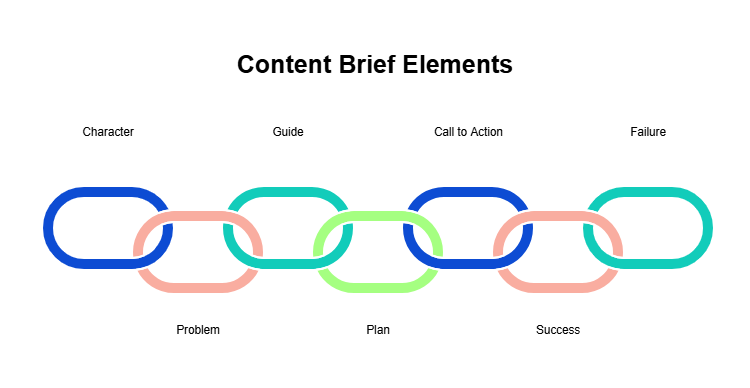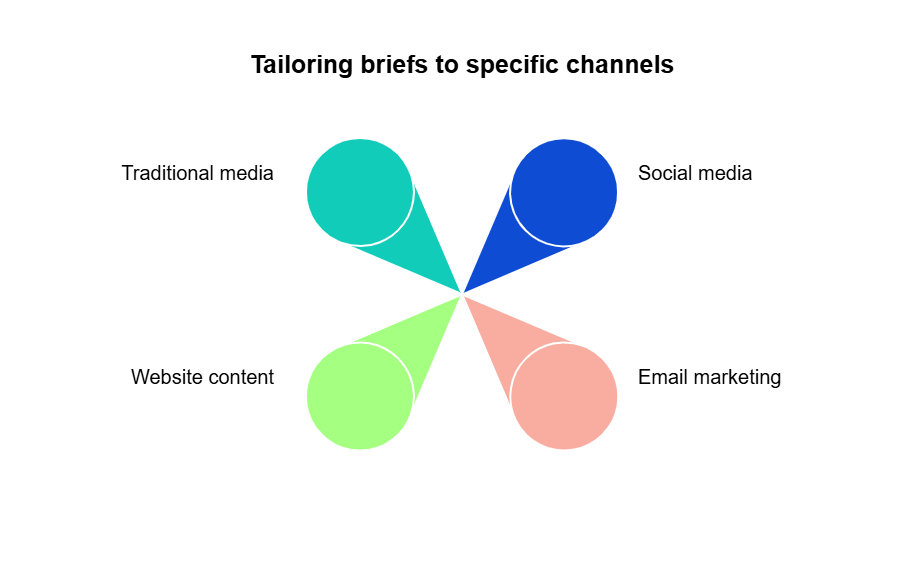A good content brief tells you what to say. A storytelling content brief tells you how to make people care.
Facts and features aren’t enough for today’s readers. People want stories with struggle and emotion. Your content needs narrative: a clear, compelling story that’s rooted in your audience’s world.
When your content brief includes a story, it stops being a checklist and becomes a strategy. It aligns your writer with your message and gives every piece of content a pulse.
At its core, a storytelling content brief blends three things: a strong narrative structure, real audience insight, and brand messaging that resonates. Get these right and your content will be remembered.
What does “storytelling” mean in a content brief?
Storytelling in an effective content brief means giving your content a clear sense of purpose. You're helping the writer understand the journey the audience should take.
At the heart of it is the “why.” Why are you creating this piece? What shift in thinking or action do you want the reader to experience? Your brief should spell out that transformation.
Maybe you’re helping IT leaders rethink their approach to compliance. Maybe you’re showing marketers a faster way to audit content for accessibility. Either way, there should be a clear narrative arc: a challenge, a change, and a payoff.

A strong brief also anchors the piece to your broader brand story or campaign theme. This keeps content marketing consistent and relevant, even across different formats or teams. This is how you create a bridge between one blog post and the bigger strategic picture.
7 elements of a content brief that’s infused with story
Yes, your content brief template should include the usual mechanical elements: title, description, SEO best practices, keyword research, meta description, word count, internal links, and other elements.
But in order to produce a proper storytelling brief, you’ll need to give your writers all the key elements of a good story. These elements come from the StoryBrand Framework, designed by marketing genius Donald Miller.
Character
Every strong story has a central character. In your content, that character is always the customer. They’re the hero, not your product or your team.
Your brief should clearly define who this person is, what they care about, and what motivates them. This helps the writer frame the content from the customer’s perspective, not your brand’s.
Problem
Heroes need challenges. Without a problem, there’s no reason to engage. Your brief should name the core problem your customer is facing. Is it inefficient? Poor visibility? Compliance risk? Spell it out in human terms.
This tension is what pulls readers in and sets the stage for your content to be genuinely useful.
Guide
So, if your brand isn’t the hero, what role does it play? The guide.
You’re the expert with a plan, helping the customer overcome their challenge. The brief should make this clear by showing how your brand demonstrates both empathy for the customer’s situation and authority to solve it.
Plan
Your brief should outline a plan to solve the readers’ problem in simple terms, whether it's a new framework, a step-by-step process, or a fresh way of thinking.
Connect this plan to the reader’s stage in the funnel. Are they just becoming aware of the problem? Actively comparing solutions? Give them the clarity they need to move forward.
Call to Action (CTA)
Every story needs momentum. Your brief should specify a direct, relevant call to action.
Your call to action (CTA) could be a product demo, a newsletter signup, or simply clicking through to a related article. The CTA should feel like the natural next step in the story: a local step toward the value you just delivered.
But avoid hard selling. That’s tacky and risks turning your customer off rather than enticing them.
Success
Writers need to know how to frame the outcome in a way that’s tangible and meaningful. Describe what success looks like for the customer.
What happens when they follow the plan and take action? Paint that picture in your brief. Do they save time? Reduce risk? Feel more confident in their role?
Failure
Don’t be afraid to address what’s at stake. Acknowledge the risk of inaction, the cost of doing nothing, or the frustrations that persist without change. This shows that you understand the customer's journey and it makes the potential reward even more compelling.
The story and your brand
Your brand identity is how people perceive you. Storytelling shapes that perception by giving your brand a personality and point of view. A consistent story across all content helps your audience remember you, trust you, and feel connected to you.
If you do this well, your brand will feel human, complete with a personality.
Stories are great vehicles for this kind of brand building. When your stories align with your brand identity, every piece of content becomes a reinforcement of who you are, what you stand for, and why your audience should care.
Without that alignment, even the most well-written piece can feel disconnected or forgettable.
Every content brief you produce should include some basic information about your brand to keep your writer in the right lane.
Brand values: Reinforce what your brand believes in. These values should shape the conflict and resolution of the story. Are you champions of innovation, inclusion, or sustainability?
Brand voice: Define how your brand speaks. Is it conversational, formal, witty, or calm? The tone of the story should match, so your voice is instantly recognizable.
Audience expectations: Great storytelling meets the audience where they are. Know what your audience expects from your brand and what would delight them.
Briefs that support narrative thinking
Storytelling takes the reader through a journey, so it helps to provide your writer with some information about the narrative you’re trying to achieve.
Core message or takeaway: What is the single most important idea the reader should walk away with?
Example: You don’t need to waste hours pulling reports from five different tools. This platform gives your team one place to track, analyze, and act on content performance.
The user’s emotional state: Describe how the reader likely feels before engaging with the content and how you want them to feel afterward.
Example:
Before reading: Frustrated and overwhelmed, spending too much time gathering data and not enough time using it.
After reading: Relieved and empowered, confident they can finally get accurate insights fast.
Desired shift in perception: What belief, assumption, or mindset are you trying to challenge or change?
Example:
From: “Reporting is a time-consuming, manual task I dread.”
To: “Reporting is an automated, strategic advantage I can rely on.”
Supporting proof points: What evidence can you provide to support the core message? Use stats, case studies, testimonials, or expert insight, but not just product features.
- Stat: Marketing teams spend an average of 6 hours a week just gathering performance data.
- Case study: A global tech company cut reporting time by 75 percent and uncovered key underperforming content they optimized for a 22 percent traffic boost.
- Quote: “It’s like having a full-time analyst on the team. We finally have a clear view of what’s working.” – VP of Marketing, B2B SaaS
Target audience snapshot: If you haven’t already, include some information about the audience. Briefly describe who the piece is for and what matters to them right now.
Example: Mid- to senior-level digital marketers and content managers at enterprise companies. They’re under pressure to show ROI and get more value from their existing content.
Story structure (optional, but helpful for writers): Frame the narrative using the StoryBrand framework we mentioned earlier. Give the writer each piece so they can put it together for you. If you want to be involved more deeply, write a content outline for the story beat-by-beat.
Example:
- Character: A marketing lead juggling multiple campaigns with limited time and reporting support.
- Problem: Wasting hours manually pulling reports from disconnected tools. No clear insight into what’s driving results.
- Guide: The platform centralizes content analytics and automates performance reporting across all channels.
- Plan: Connect tools, set KPIs, schedule automated reports, and monitor trends over time.
- Call to Action: Start a free trial or request a live walkthrough.
- Success: They save time, get reliable insights, and make smart content decisions.
- Failure: They stay stuck in reactive mode, miss growth opportunities, and struggle to prove marketing’s impact.
A creative brief with these elements creates something bigger than just a blog post. It tells a story that connects, persuades, and builds brand value with each piece of content.
Storytelling across diverse marketing channels
The language you use in a TikTok caption is different from the language you use in a 30-minute podcast appearance. The channel and format simply require different approaches to content creation.
This means it’s important to tailor your storytelling content briefs to fit different marketing channels and help your message land with impact.
Tailoring briefs to channel-specific needs

Each marketing channel has its own language, constraints, and audience expectations. Your content brief should reflect those nuances. Here’s how to adapt your narrative for different environments:
Social media
- Focus on brevity, emotion, and immediacy.
- Emphasize the hook. What stops the scroll?
- Visual storytelling and tone take center stage.
- CTAs must be low-friction (like, comment, click).
Email marketing
- Use a personal tone and direct language.
- Stories should be compact but persuasive.
- Subject lines and preview text carry the narrative weight.
- CTAs align with subscriber intent (e.g., download, learn more).
Website or blog content
- More space for depth, structure, and supporting proof points.
- Strong SEO integration, but without diluting the story.
- Clear alignment with user journey stages (awareness, consideration, decision).
Traditional media (PR, print, TV)
- Stories must stand alone — no clicks, no follow-ups.
- Emphasis on brand reputation, authority, and emotional resonance.
- Tightly controlled language and visuals to meet legal or editorial standards.
Social vs. traditional: A quick comparison
The short form of social media content makes it a unique case when designing content briefs.
Content briefs for social media content should prioritize agility and emotional engagement, as you only have a few seconds to make a connection with the user.
On the other hand, briefs for traditional media (like articles, press releases, or email campaigns) have the freedom to emphasize message control, clarity, and alignment with your brand.
| Element | Social Media Brief | Traditional Media Brief |
|---|---|---|
| Length | Short and punchy | Long-form and comprehensive |
| Tone | Conversational, real-time | Polished, authoritative |
| Visuals | Central to the story | Supplementary or static |
| CTA | Lightweight, often implicit | Clear, formal call-to-action |
| Pacing | Fast, high frequency | Slower, more deliberate |
Consistency across an omnichannel content strategy
It's easy to lose your brand message when you are creating content for lots of different platforms. Even something as simple as chopping a YouTube video into TikToks can dilute your messaging to the point of irrelevance.
Your storytelling content briefs can help you keep your narrative consistent across those channels by serving as a single source of truth. Let your briefs be the genesis of all of that content: a narrative anchor, if you will, so content creators have everything in one place.
Some brands like to have everyone work in the same document to preserve the messaging. After the article writer finishes his job, the social copywriter comes into harvest or generates social media posts.
This collaborative work system keeps your message in check. It’s also faster for everyone involved because there’s no duplicated work.
Leveraging tech to craft storytelling content briefs
Storytelling is a creative art, but we can still use technology to craft, scale, and refine our content briefs and the content itself.
- Generative AI (Claude or ChatGPT) for idea generation, outlining, or repurposing existing content.
- Content intelligence tools (like Siteimprove) to build a creative brief with accessibility scores, performance metrics, and SEO data.
- Project management tools (like Asana, Monday.com, or Trello) to keep the creative team and deadlines clear.
- Content management systems to store, update, and distribute briefs in one place.
- Collaboration tools (like Notion, Google Docs, or Confluence) for real-time editing and feedback.
- Analytics platforms to pull insights and performance data that shape better briefs.
- Style guide and writing tools (like Grammarly or Writer.ai) to maintain tone and clarity.
- Digital asset managers to organize visuals, templates, and brand-approved elements.
- Workflow automation tools (like Zapier or Make) to streamline briefing, approvals, and handoffs.
As always, data is an important part of the content creation process here. Storytelling becomes sharper when it’s backed by audience insights.
Use data to validate assumptions about your reader’s needs, motivations, and challenges. Try to identify which topics resonate, how long users stay engaged, where they drop off in the journey, and what content formats perform best.
Stories that drive action
You might think of your content brief as a mere writing tool to point your content creator in the right direction. As you can see, it’s a lot more than that. It’s a part of your content strategy that gives your team the structure and emotional clarity to create content that moves people.
When your creative brief centers around the reader’s journey, aligns with your brand’s identity, and adapts to each channel’s strengths, you set the stage for content marketing that genuinely connects.
And connection is what drives potential customers to take action.

